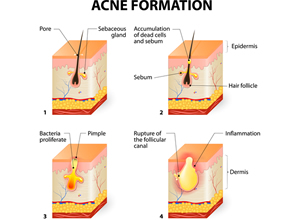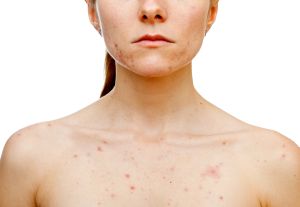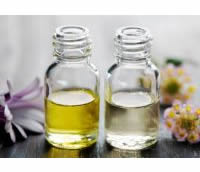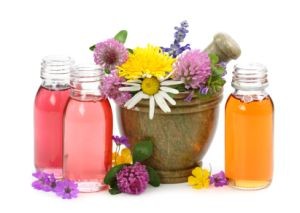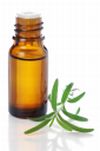Acne
Acne is a disease that affects the skin’s oil glands. Sebaceous glands are tiny, oil producing glands connected to hair follicles beneath the surface of the skin. The sebum moves up the hair follicle to the opening of the follicle. However, if there are dead skin cells, the sebum acts like glue and together block the pore forming a plug. Normally harmless bacteria that live on the skin can contaminate and infect the plugged follicles, causing papules, pustules, nodules or cysts. It can be painful, particularly when it’s severe. It can also cause emotional distress. Acne that appears on your face can impact your self-esteem and, over time, may cause permanent physical scarring. Teenage acne is thought to be triggered by increased levels of a hormone called testosterone. This hormone increases the production of sebum which makes the skin oily.
Triggers
Hormones
Increased levels of testosterone in teenagers causes too much sebum production. Women experience hormonal fluctuations during their productive years and in menopause. From the late 20’s, estrogen levels decline faster than testosterone. This can contribute to adult acne. If you have small red bumps or spots along the jawline, this is an indicator of hormonal imbalance.
Dairy consumption can also be problematic for people with skin conditions, especially because of some of the hormones found in milk. Because milk comes from a lactating animal, hormones are present in the milk. These are active hormones which can affect proper functioning of the sebaceous glands, worsening some skin conditions.
Hormone disrupting chemicals like parabens (mimics oestrogen) found in cosmetics can cause havoc with hormones and skin disorders.
Pollution
Air pollution from car exhausts, factories and power plants etc., contributes to free radicals, and can contribute to other skin-related issues.
Medications
Some medications such as cortico steroid medications, lithium (prescribed for bipolar disorders) and the contraceptive pill can trigger acne. These are synthetic hormones.
Skin care and make-up products
Research shows that hormone disrupting chemicals in skincare products have been linked to a number of health problems. Many of them mimic estrogen like parabens. SLS’s can increase the skin’s pH level and can dissolve the natural oil your skin produces. Mineral oil/ Petrolatum (Petroleum Jelly) is by product of petroleum. It can not be absorbed by the skin and creates a film on the surface, blocking the pores and preventing the skin from its normal functioning.
Poor Skin Nutrition
Lack of vitamins and minerals can make skin lifeless, blotchy, dry, or oily.
Poor Consumption of Healthy Fats
We need healthy fats (omega-3 & 6 fatty acids) to absorb fat soluble vitamins. They also improve skin elasticity, and help prevent wrinkles.
Lifestyle and dietary habits
Refined foods and simple carbohydrates causes sugar spikes which increases insulin. High insulin levels increases the sebaceous glands oil production. Dairy is also linked to increased testosterone which is linked to acne.
The Solution
The truth is that many people turn to prescription medications or chemical treatments to treat acne and other skin disorders. Quite often these products contain harsh chemicals that will have side effects or may not even work at all.
Diet
A diet rich in vegetables, fruits, lean protein, healthy fats, nuts and seeds is good for our skin because it contains many vitamins, antioxidants and minerals that promote a healthier skin and help to balance hormones. A good diet combined with movement/exercise will help lymph flow which in turn helps to eliminate toxins.
Stress Management
Stress causes constriction of the blood vessels, creates free radicals and acid environment, disrupts hormonal activity, and impedes the absorption of nutrients and normal cellular activity. Stress disrupts the PH balance of the skin and also the acid/alkaline balance in the body. It produces excess cortisol, which in turn pumps more sugar into the system, creating havoc with our hormones, increasing insulin which leads to overproduction of sebaceous glands and therefore oily skin and it also creates difficulties sleeping well at night. This manifests in high amounts of inflammation creating free radicals and damaging our cellular membranes and in turn pre-mature ageing and problem skin.
Physical activity plays a key role in reducing and preventing the effects of stress. Make time for fun and relaxation. It is important to balance all areas of our life for health and wellbeing. The 7 primary areas to a well balanced life are physical, emotional, mental, occupational, social, financial and spiritual. All these areas must be balanced for us to have a happy and fulfilled life and thus less oxidative stress internally helping us to have healthier skin.
Oil Cleansing
Use the oil cleansing method. Using oils for oily skin is the most effective way to cleanse and balance excess oil (sebum) naturally. Over cleansing and harsh chemical facial cleansers only exacerbate the situation by producing more sebum to counteract what was stripped away.
Vegetable oils
Using natural home made remedies are gentle on the skin and more effective at killing bacteria and soothing the skin from irritation. These remedies include organic vegetable oils which nourish, repair the skin, balance sebum production and essential oils which help to tackle the root of the problem by balancing the body from the inside out.
Vegetable oils are pure, potent goodness, delivered by nature. Vegetable oils are natural emollients that nourish the skin, protect the skin’s lipid barrier and contains vitamins and essential fatty acids. Vegetable oils are primarily used for their skin repairing properties and cellular regeneration. The molecular structure of vegetable oils are larger than essential oils and so it takes longer to penetrate the skin which enables the skin to be nourished whilst protecting the PH acid mantle. They help to rebalance our natural lipids and normalise skin conditions.
1. Coconut Oil
Coconut oil contains high anti-bacterial, anti-viral and anti-fungal properties. It is very effective for acne by reducing inflammation, improving immunity and balancing the microbiome.
2. Unrefined Shea Butter
High in Vitamin A, it is a suberb moisturiser with exceptional anti-bacterial and anti-inflammatory properties properties.
3. Thistle Oil
The plant is a member of the Compositae family which is renowned for it anti-inflammatory properties. It is excellent at clearing congested skin and reducing large pores.
4. Apricot Kernel Oil
Apricot Kernel oil is very light. It is very soothing for inflamed, irritated skin and high in Vitamins C and E. Apricot kernel is a good general moisturizer for most skin types.
5. Evening Primrose Oil
Very high in Gamma Linolenic Acid (GLA) – easily absorbed by skin, has moisture-retaining effect and helps prevent drying of the skin. It is closely related to linoleic acid (Omega 3). Both are substances the body needs to create prostaglandins which helps to reduce inflammation.
6. Rosehip Oil
Good for oily, large-pored, combination & sensitive skin, as well as many skin problems including acne. Rosehip is amongst the best vegetable oil source of omega 3 and is also a good source of omega 6 (GLA), both essential fatty acids collectively known as vitamin F, involved in cellular membrane and tissue regeneration and normalising skin with large pores.
7. Jojoba Oil
Jojoba oil is a liquid wax that mimics sebum. This helps to balance the production of sebum which contributes to acne.
Essential Oils
Essential oils have the power to kill bacteria on the skin naturally. Essential oils for acne, such as lavender and clary sage, have the ability to alleviate feelings of stress and anxiety, fight sleeping difficulties, and balance hormone levels. They are also gentle on the skin and have a number of benefits that go beyond fighting skin disorders and promoting skin health. Blend essentials oils to a dilution of .5% for the face and 1.5% for the body.
1. Tea tree
Tea tree oil contains anti-microbial and anti-fungal properties.
2. Lavender
Lavender oil helps to heal scarring and is soothing on the skin. It has a relaxing effect when inhaled from the bottle. Stress is often connected with skin disorder flare ups in times of increased anxiety and stress. We produce more sebum, making the skin more oily in times of stress. Lavender oil is a powerful tool when it comes to reducing stress levels.
3. Clary sage
Clary sage regulates the production of sebum on the skin and it supports hormonal balance. Clary sage is also know to improve mood in times of anxiety and stress.
4. Juniper berry
Juniper berry is a powerful anti-oxidant helping to combat free radicals in the body and aiding in cell regeneration. Juniper berry has anti-microbial and anti-fungal properties.
5. Bergamot
Bergamot promotes fast wound healing, scars and inhibits the formation of new infections. It is a gentle skin cleanser and tones the skin. Effective anti-depressant. Highly anti-bacterial, anti-viral and anti-fungal.
6. Frankincense
Frankincense boosts the immune system, reduces stress, can reduce acne blemishes, heals wounds and scars and helps reduce the appearance of dark spots on the skin.
7. Lemon
Lemon essential oil helps to cleanse the skin, stimulates lymphatic drainage and improves skin complexion.
Have you tried any of these oils yet? Let me know if you use anything in addition to the ones listed here.
If you enjoyed this article and want to know more, check out our online courses or join our Aromatherapy Empowerment Facebook Group where we offer free advice & tips, recipes and more…

